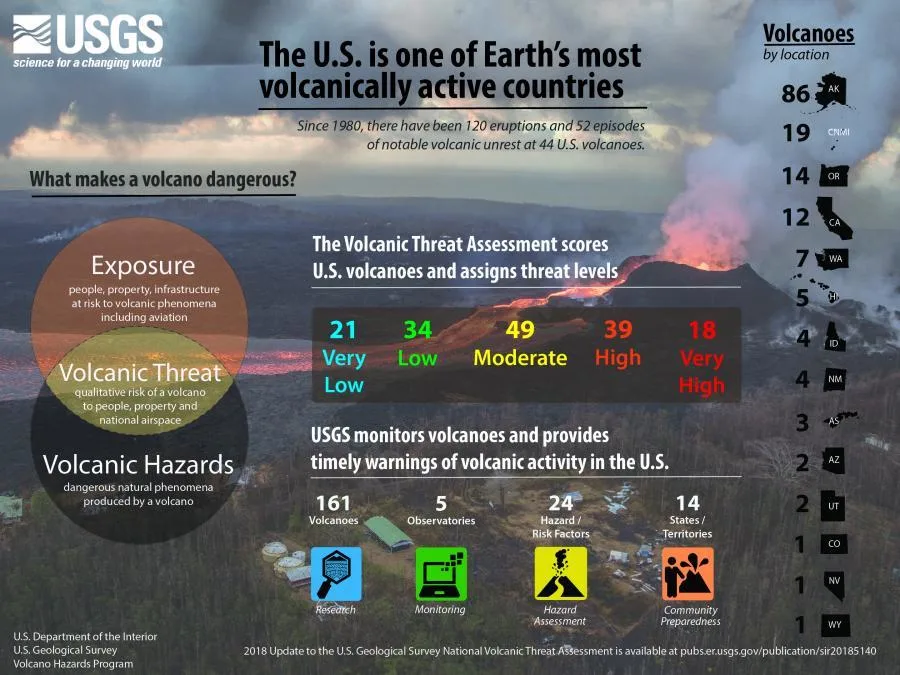More than 120 volcanic eruptions have occurred in the United States in the 42 years since Mount St. Helens erupted over Washington in 1980, killing 57 and inflicting over a billion dollars in property damage. While none have been nearly as destructive, their mere presence can impact human activities and even economies hundreds of miles away. Altogether the US Geological Survey (USGS) has identified 161 geologically active volcanoes in 14 states and territories, a third of which constitute “high” or “very high” threats to their surrounding communities, and another 58 volcanoes nationwide classified as being undermonitored. The agency operates five volcano monitoring stations along the west coast to keep an eye on all but the least dangerous as part of the Survey’s Volcano Hazards Program. On average, around 60 volcanoes erupt annually, as Hawaii’s Mauna Loa is doing right now.
Mauna Loa, which had stood dormant for the past 38 years, reawakened late Sunday night for the eighth time since 1843. “Lava flows are not threatening any downslope communities and all indications are that the eruption will remain in the Northeast Rift Zone,” reads Monday’s red alert update from the USGS Hawaiian Volcano Observatory (HVO). “Volcanic gas and possibly fine ash and Pele’s Hair may be carried downwind. Residents at risk from Mauna Loa lava flows should review preparedness and refer to Hawai’i County Civil Defense information for further guidance.” This week’s eruption is decidedly mild compared to 2018’s Kīlauea Volcano event that destroyed 700 homes and launched ash 3,000 meters into the atmosphere, where it disrupted air traffic patterns.
While lava receives a majority of the public attention, volcanoes have myriad methods for ruining your week with fire and (literal) brimstone. Volcanic ash can travel miles into the stratosphere before raining back down where it is exacerbates chronic lung diseases like asthma and emphysema; carbon dioxide and hydrogen sulfide collect in low-lying areas to suffocate the unwary and seismic shifts resulting from the initial explosion can trigger landslides, tsunamis, floods, and large-scale power outages.
“Unlike many other natural disasters … volcanic eruptions can be predicted well in advance of their occurrence if adequate in-ground instrumentation is in place that allows the earliest detection of unrest, providing the time needed to mitigate the worst of their effects,” David Applegate, USGS associate director for natural hazards, told a House subcommittee in 2017.
As Eos magazine points out, nobody died as a result of the 2018 Kīlauea eruption, in large part due to the efforts of monitors at the HVO. But, the 2018 threat assessment found that, out of the 18 volcanoes listed as “very high” threat, only three — Mauna Loa, St Helens and the Long Valley Caldera — were rated as “well monitored” when that eruption was happening.
On the same day that Kīlauea blew its top, the US Senate unanimously passed S.346establishing the National Volcano Early Warning and Monitoring System (NVEWS). The following March, the House of Representatives passed its version, PL 116-9/S.47, dubbed the John D. Dingell Jr. Conservation, Management, and Recreation Act. Not unlike California’s new ShakeAlert early earthquake warning scheme, the NVEWS works to combine and standardize the existing hodgepodge of (often outdated) volcano monitoring hardware operated by both government agencies and academic organizations into a unified system“to ensure that the most hazardous volcanoes will be properly monitored well in advance of the onset of activity.”
USGS
“Improvements to volcano monitoring networks allow the USGS to detect volcanic unrest at the earliest possible stage,” Tom Murray, USGS Volcano Science Center director, said in a 2018 USGS release. “This provides more time to issue forecasts and warnings of hazardous volcanic activity and gives at-risk communities more time to prepare.”
The NVEWS Act, which was sponsored by Senator Lisa Murkowski (R – AK), earmarks $55 million annually between 2019 and 2023 to provide more accurate and timely eruption forecasts by increasing partnerships with local governments and proactively sharing data with the volcano science community. It also seeks to increase staffing and systems — from broadband seismometers, infrasound arrays, and real-time continuous GPS receivers, to streaming webcams, satellite overwatch and volcanic gas sensors — for 24/7 volcano monitoring and establishes a grant system for furthering volcanology research .

USGS
The USGS ranks volcanic threats based on the risk they pose to public health and property — essentially how potentially destructive the volcano itself is in relation to how many people and things might be impacted when it erupts. The USGS assigns numerical values to the 24 various hazard and exposure factors for each volcano, then combined to calculate the overall threat score which is divided into five levels (like DEFCONs!). High and Very High get the most detailed monitoring coverage because duh, Moderate threat volcanoes still receive real-time monitoring but don’t have Tommy Lee Jones standing by to intercede, and Low (and Very Low) get checked on as needed. As of May 2022, when the USGS submitted its second annual NVEWS report to Congress, the USGS had spent just under half of the money appropriated for FY 2021 with the funds going to activities like installing a net-gen lahar detection system on Mount Rainier, upgrading the telemetry for more than two dozen observation posts throughout Alaska, Oregon, Washington, California and Hawaii.
All products recommended by Engadget are selected by our editorial team, independent of our parent company. Some of our stories include affiliate links. If you buy something through one of these links, we may earn an affiliate commission. All prices are correct at the time of publishing.